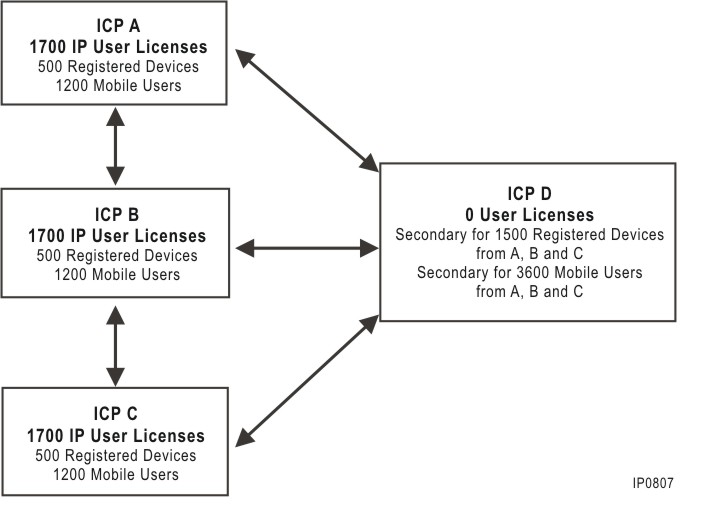
To fully understand the increased capacity of the 1400-User System configuration, a 700-user configuration is provided, followed by an example of the 1400-user configuration.
The following example of a 700-user application highlights its limitations. The 700-user configuration has practical limits to the number of real devices on a 3300 ICP, usually one fourth of the physical limit (the number IP PLIDs) available on the IP Virtual Peripheral (ViPer) node.
Each resilient user has an IP PLID on both its primary and secondary ICP. A mobile user can potentially use an IP PLID on four separate switches: primary and secondary Registration DN, and primary and secondary Mobile DN. The example below illustrates the limitation of Active IP devices on two 3300 ICP switches. Each switch has a maximum number of 700 devices programmed.

Both switches are programmed fully with 700 user profiles. A registered device uses one resource (IP PLID) on its primary ICP and one resource on its secondary ICP, so 350 resources are used on each ICP. Because registered devices and mobile users on their primary ICP each use one license, 350 IP User Licenses are necessary. The physical capacity of the ICP is under-utilized, for example, all 700 resources are used, but only 350 devices and IP User Licenses can be sold.
The 1400-user configuration allows a much greater percentage of licenses to be occupied by physical devices.
The example below illustrates how a 1400-user configuration is implemented in large installations. In this example, a resilient cluster uses "N + 1" resiliency, that is, N servers depend upon a single server for resilient behavior.

ICP A, ICP B, and ICP C are programmed with 500 physical devices and 1200 Mobile users. For this example, there are three shifts of 400 employees with 500 physical devices, with 100 extra devices with default users. ICP D is capable of being programmed as the secondary for all 1500 devices and all 3600 Mobile users; however, it can handle only 1400 of the devices at any one time. Therefore, if every ICP other than ICP D failed, 100 devices would not be able to register.
This 1400-User system configuration can be used in the following cases:
Shift workers – Each shift worker could have his/her own mobile DN, but use any IP device available. This is possible because the 3300 ICP has the capability for more configurable IP devices than active devices. For example, with three shifts of 1000 workers, there could be 3000 mobile DNs, and you could login to any of these mobile DNs on any of the 1000 active IP devices.
"N + 1" resiliency – A resilient device requires that it is configurable on its secondary controller. This requires an IP PLID. One ICP can provide resiliency to many ICPs since there are more configurable IP devices than active devices.
